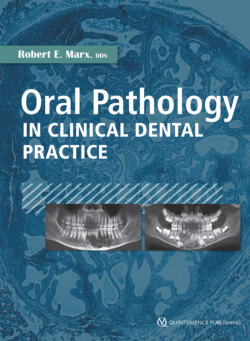Читать книгу Oral Pathology in Clinical Dental Practice - Robert E. Marx - Страница 8
На сайте Литреса книга снята с продажи.
Оглавление1
Recognizing Abnormalities and Pathologic Conditions
This book is the progeny of a previous two-volume comprehensive oral and maxillofacial pathology text written by this author and pathologist Diane Stern. The original volumes included detailed workups, differential diagnoses, and treatments aimed at treatment providers, predominantly oral and maxillofacial surgeons. However, it is usually the practicing restorative dentist or another specialist that recognizes an abnormality or a pathologic condition during the patient visit. It is for these practitioners that this text is provided. Although it discusses the final treatment of each lesion, it more importantly advances a “suggested course of action” that the recognizing practitioner should consider.
The recognition of abnormalities and pathologic conditions requires a three-pronged approach of “listen-look-plan” and is within the training and scope of every dentist.
Listen
The “listen” part begins with the patient’s chief complaint. If you listen carefully, the patient may actually tell you his or her diagnosis, which you can either confirm or refute or use to lead you to the next phase of recognition, the history of present illness (HPI). In the HPI, one should attempt to ascertain when the complaint began, whether it has increased in size or involved other areas, what makes it better or worse, what may have started it, and whether it has been treated before. The third phase of the “listen” part is the past medical history (PMH), which is best accomplished by an intake PMH form. The dental provider can use this form to ask more detailed questions about any admitted conditions. In addition, a short, focused, verbal PMH pertinent to dental providers should include the following 10 important, directed questions:
1.Do you have any medical conditions you take medicine for?
2.What medications do you take?
3.Do you take any blood thinners?
4.Do you take a medicine for osteopenia or osteoporosis?
5.Have you ever had a cancer anywhere in your body?
6.Have you taken medicines for cancer?
7.Have you received radiation treatments to your mouth area, neck, or throat?
8.Are you allergic to any medications? If so, what type of reaction did you get?
9.Do you have a heart murmur?
10.Have you had any previous surgeries?
Look
The “look” part involves an oral examination that every dentist is well trained to do. The examiner is cautioned to resist the natural inclination to focus on the obvious dental or periodontal needs of the patient and instead look at all areas of the oral cavity. In particular, examine the chief complaint and the dentition last; neither will disappear during your examination. Be sure to look at the more hidden places in the oral cavity such as the posterior lingual mandible, the hamular notch area, and the posterior lateral border of the tongue, which may require a gloved hand pulling the tongue forward. Today it is also prudent to examine the face and neck for obvious skin lesions and masses as well as the patient’s overall appearance and gait.
The second phase of “look” involves what can be done to find out more about the lesion if one is found. That is, is it painful to touch? Does it blanch on palpation? Is it firm, hard, doughy, or soft? Does it have a specific color? Is it movable of fixed? Is it ulcerated, blistered, raised, or flat?
Plan
The “plan” part involves a decision that each dental provider must make: Is this abnormality or pathologic condition something I have the training and experience to diagnose and treat, or is this something I should refer to another individual provider? It is hoped that the “suggested course of action” included with each presentation within this text provides a guideline to answer that question.
